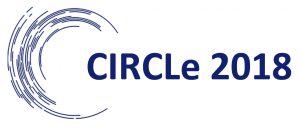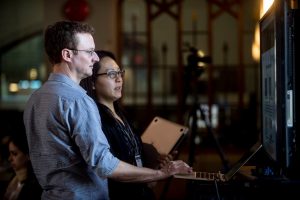Capturing and Reflecting the Learning Process through ePortfolios, 11:00 am to 12: 15 pm
To see all table discussion notes for this session, click here
Questions framing the presentations in Session 1:
- How can learning can be processed and represented using e-portfolios and online platforms?
- What do online platforms capture that other forms might not? What is problematic about using digital spaces for reflective practices?
- How can students use e-portfolios in more critical and reflexive ways?
- How should educators pedagogically distinguish between using e-portfolios as a tool for personal versus professional identity development?
- What are some best practices for documenting difficult, authentic, and complex learning experiences?
TABLE 2 DISCUSSION:
For Christine D’Onofrio’s use of eportfolios:
This discussion was moderated by Christine D’Onofrio, which allowed an opportunity to expand on some of the presentation content.
- Students really like the look of Wix.com (versus UBC platform) but when using a template, students were dependent on the design of the template. The templates became restrictive for students, or encouraged a superficial approach. Is this partly because they were Media Studies students?
- Maybe because they were visual design students, they were more aware of how they wanted their eportfolios to look like but were not deconstructing the limitations of the template or what the template was conveying for them by these pre-loaded options?
- Wanting students to really think about the purpose of their site. Academic art is about deconstructing meaning and process. What does a Wix template say?
- New tweaks for Christine’s course:
- Students need to use WordPress instead of Wix.com
- Encouraged students to develop research questions for all of their courses that would be reflected in the ePortfolio
- Evaluation is less about what it looks like but more focused on artifact critique
- Evaluating process and reasoning why decisions were made
For David Gaertner’s incorporation of eportfolios:
- Used Omeka
- Working with a community to reflect a community project
- Did a critical analysis on websites and then completed a reflection
Other comments:
- Students are frustrated they can’t make WordPress look the way they want, and it’s too difficult to support
- Q: Can paper templating help them be more thoughtful in the transition to a digital format?
- Takes time for students to learn skills necessary to create an eportfolio.
- Encourage them to settle on a first theme within the first couple of weeks, but let them know they don’t have to be married to it — at Royal Roads they may have more support
- Set time limits for students to spend on assignments as some students get obsessed with things like rollovers which takes time away for more valuable reflection and learning.
- “Ask 3 then me (including Google)” – Idea of asking three other peers (including Google) to find the answer before approaching instructor than instructional support
- Hoping that students learn and receive feedback from each other
Networking ePortfolios: Integrating Technology with Learning and Connecting to the Real World, 1:30 pm to 2:45 pm
To see all table discussions for this session, click here
Questions framing the presentations in Session 2:
- How can educators encourage students to make connections between their academic work and life experiences?
- How might we better integrate e-portfolios in courses to improve student engagement?
- What kinds of projects get students to use the technology effectively, both during and after the course?
- What are the shared overlaps and differences between learning portfolios and career portfolios?
TABLE 2 DISCUSSION:
What kind of projects get students engaged when using tech?
- Projects that are relevant to their interest
- Projects where time spent learning new tools is reasonable for what they are trying to achieve and the end product they are expected to produce
- Projects and products authentic to their fields of interest
- Show them examples of working professionals/academics in their field and how they are using these tools/samples in their own work
Other comments:
- Research shows that learning styles not true; they are more preferences
- Importance of creating opportunities for reflection and providing further questions to reflect on in feedback
- Learning how to turn experiences into artifacts (Christine mentioned a particular article about this)
- Portfolios really help you synthesize what you’ve done, and just to remember it
- Co-op reflections can be used as a prep device for job interviews
- A more reflective process could be an excellent job skill
- Q: How to create a reflection that’s shareable?
Learning vs Career portfolio?
- at Royal Roads University, really easy because they have professional programs
- Issue that Royal Roads hasn’t made a commitment to keep them available forever, but students can export – Students also don’t have an alumni authentication system
- Learning portfolio – a great way to remember their learning
- School of communication at Royal Road has a community of practice
- Like Capilano’s idea of having a course re: eportfolios near the end of students’ degrees
- Destroying dichotomy of one or the other? Reflective process should be accepted into the profession
- Eportfolio needs the ability to hide things that you don’t want to show right now
- Tailoring your portfolio may be key. The ability to hide some items in the job search.
- Ability to transfer your work easily from one platform to another
- Q: How do we archive these student-created media
- Q: How are ePortfolios preserved
- Q: Student engagement, and making connections between academic and life experiences
Learning through Assessment and the Future of ePortfolios, 3:15 pm to 4:30 pm
To see all table discussion for this session, click here.
Questions framing the presentations in Session 3:
- What might institutional learning cultures (academic, universities, colleges) learn from e-portfolio cultures (professional careers, visual arts, performing arts) regarding approaches to assessment?
- What are best practices for creating ‘folio cultures’ for the future of education?
- What are the incentives, benefits and challenges for faculty, students and programs to use e-portfolios or personal web spaces?
- What can we do to get more value from these digital tools?
TABLE 2 DISCUSSION:
How we can create eFolio cultures?
- Creating/reactivating communities of practice but making it reasonable in terms of time schedules
- Ability to learn from others and not operate in silos
- Reactivating the UBC Community of Practice for portfolios may be helpful for campus-wide sharing. Lucas Wright ran this in 2013 and kele worked on this in the early 2000s
Meeting a couple of times a year would be helpful, after the TLEF is wrapped up.
- UBC Education – eportfolio was mandatory for a while, but no longer — developed to match 8 standards students needed to get certified to teach in BC
- Need to know the culture and particular context at the time to build a culture
- K-12 may force us to be more responsive to ePortfolios
Challenges with assessment?
- Get students to self-assess on a rubric/framework that is provided. Declare which objectives or outcomes they’ve achieved. Ask students to explain how their artifacts reflect competencies
- The issue is that scholarships, fellowship, etc. tied to grades, so instructors feel they need to give grades so students are eligible for these awards
- Some faculty don’t even know what are the learning outcomes for their department
- We need to be accountable to our students and for accreditation when applicable
- Suggestion based on past system at Royal Roads University where program objectives became known as numbers and learning outcomes for courses were recognized as letters.

